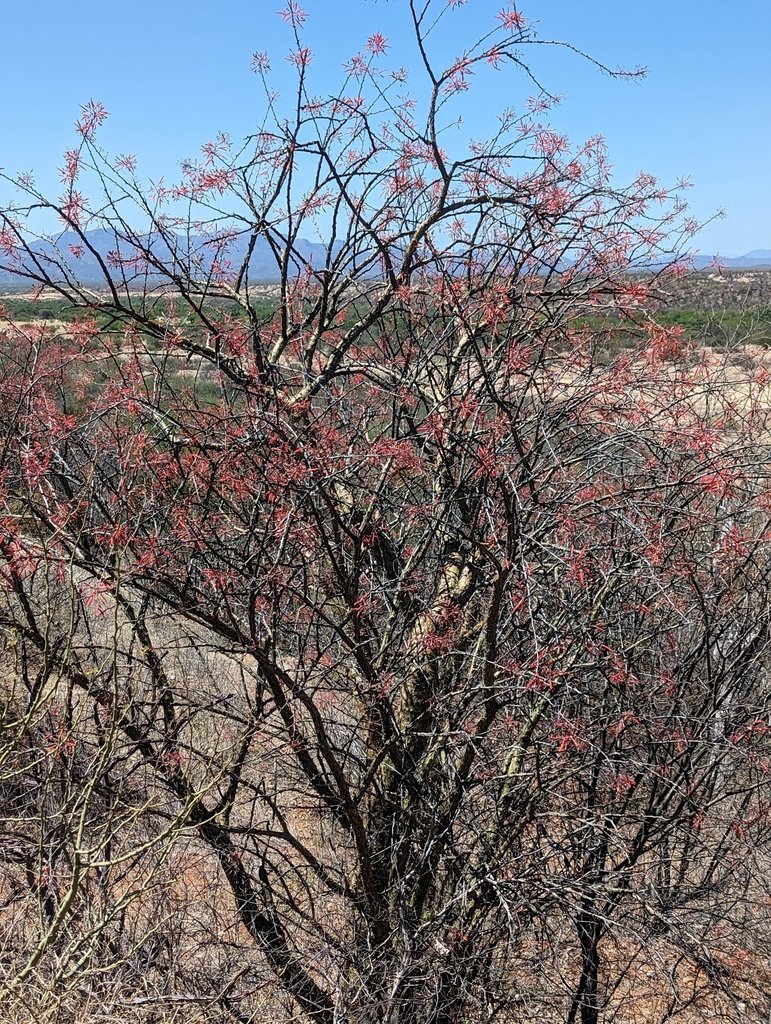Mexican Tree Ocotillo
Fouquieria macdougalii
Also known as Chunari, or Torotillo (and a handful of other Spanish names), this species has long, spiny branches, often referred to as “canes”, which arise from a short thick trunk. Mature plants can reach 25’ in height (a few known specimens are over 40’), but typically plants in cultivation are found much smaller. The small green leaves that line the branches are drought-deciduous, but will remain on the plant with supplemental irrigation, just about year-round unless temperatures dip low. Bright red flower clusters appear in the spring and fall, and may bloom intermittently throughout the year. The somewhat pendulant flowers are held at the tip of the branches in clusters, giving the effect of a red sparkler.
The species is distinguished by its small tree habit with slender, divaricate, often terminally pendulous branches, its open, nearly rounded corymbose panicles with delicate peduncles and pedicels and the bright red, narrow, cylindrical, decandrous flowers with erect corolla lobes
Plant in full to part sun. Plants are drought tolerant but plants in the ground benefit from watering 2-3 times a month in summer (in containers, 2-3 times a week). In winter, keep on the dry side, but if it doesn’t rain, water them about once a month. Container plants should be watered about once a week in winter. Plants are reported to be hardy to 15°F, but it is advisable to protect them from frost, especially younger plants. Below 20° there will be some tip damage, and below 25° the leaves will drop.
The flowers are pollinated by hummingbirds.
Ethnobotanical uses are not well-documented but plants in this genus have been used as medicine almost wherever they occur. Flowers are edible.
The species name, macdougali, is named after Daniel Trembly Macdougal (March 16, 1865 – February 22, 1958) an American botanist and writer whose living specimen of this species flowered at the New York Botanical Garden and eventually caused another botanist, George Valentine Nash (May 6, 1864 – July 15, 1921), to revise the family.
Fouquieria macdougalii ranges from sea level to about 2000’ in elevation from the Sonoran Desert of central Sonora southward to the tropical deciduous forest along the Sierra Madre Occidental of southeast Sonora and adjacent Chihuahua and to the thorn forest of south-central Sinaloa on alluvial rocky flats and slopes on granitic and to a lesser extent volcanic based soils. It also grows on open lava beds. In the tropical deciduous forest the soils are much richer, often loamy.
A somewhat younger, leafed-out specimen. Photo by hernandodecelayensis, iNaturalist
The "sparkler"-like flowers, photo by Miguel Gastelum, iNaturalist
The seed capsules, which are open and dropping the flat, winged seeds. Photo by Eric Hough, iNaturalist
The trunk exhibits a similar look as other Fouquierias, with peeling bark, and somewhat translucent, greenish, cuticle texture. Photo by jorgeortizv, iNaturalist
A mature, dormant specimen. Photo by Tereka Lasso, iNaturalist






